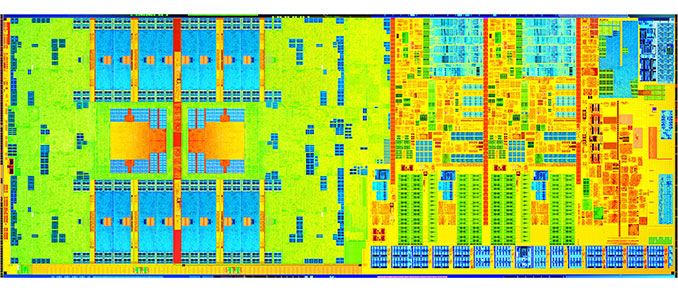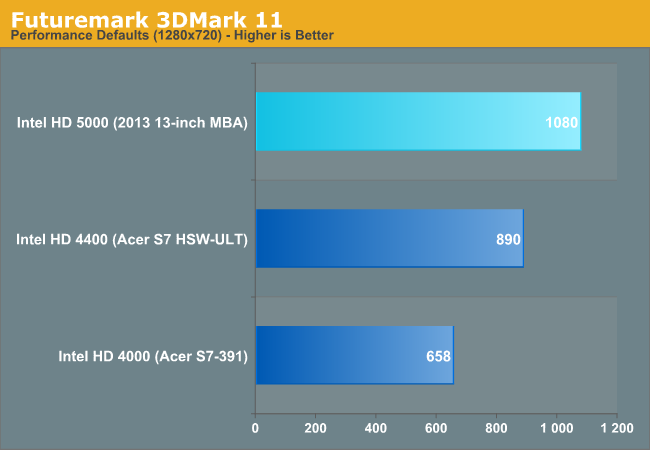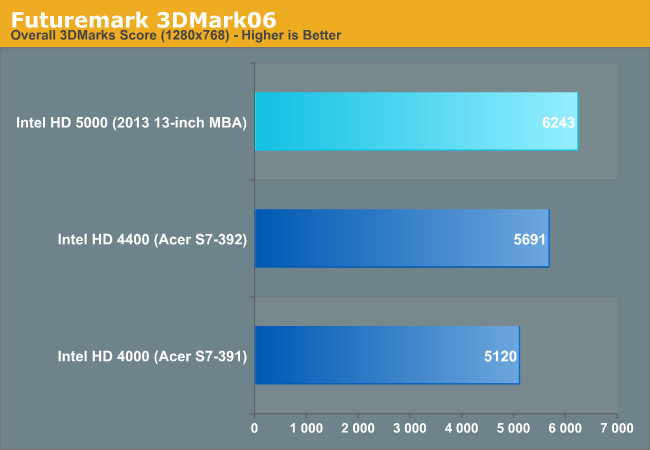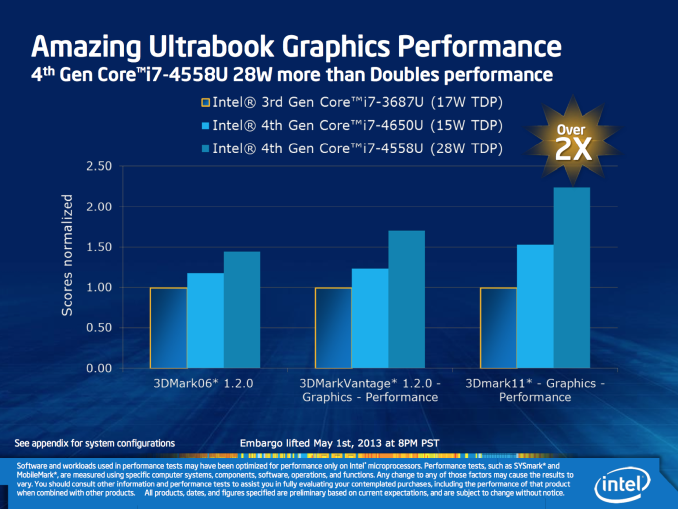A Look at Intel HD 5000 GPU Performance Compared to HD 4000
by Anand Lal Shimpi on June 24, 2013 6:02 PM EST
When I got my hands on a Haswell based Ultrabook, Acer's recently announced S7, I was somewhat disappointed to learn that Acer had chosen to integrate Intel's HD 4400 (Haswell GT2) instead of the full blown HD 5000 (Haswell GT3) option. I published some performance data comparing HD 4400 to the previous generation HD 4000 (Ivy Bridge GT2) but added that at some point I'd like to take a look at HD 5000 to see how much more performance that gets you. It turns out that all of Apple's 2013 MacBook Air lineup features Haswell GT3 (via the standard Core i5-4250U or the optional Core i7-4650U). Earlier today I published our review of the 2013 MBA, but for those not interested in the MBA but curious about how Haswell GT3 stacks up in a very thermally limited configuration I thought I'd do a separate post breaking out the findings.
In mobile, Haswell is presently available in five different graphics configurations:
| Intel 4th Generation Core (Haswell) Mobile GPU Configurations | ||||||||
| Intel Iris Pro 5200 | Intel Iris 5100 | Intel HD 5000 | Intel HD 4400 | Intel HD 4200 | ||||
| Codename | GT3e | GT3 | GT3 | GT2 | GT2 | |||
| EUs | 40 | 40 | 40 | 20 | 20 | |||
| Max Frequency | 1.3GHz | 1.2GHz | 1.1GHz | 1.1GHz | 850MHz | |||
| eDRAM | 128MB | - | - | - | - | |||
| TDP | 47W/55W | 28W | 15W | 15W | 15W | |||
The top three configurations use a GPU with 40 EUs, while the HD 4400/4200 features half that. Intel will eventually introduce Haswell SKUs with vanilla Intel HD Graphics, which will only feature 10 EUs. We know how the Iris Pro 5200 performs, but that's with a bunch of eDRAM and a very high TDP. Iris 5100 is likely going to be used in Apple's 13-inch MacBook Pro with Retina Display as well as ASUS' Zenbook Infinity, neither of which are out yet. The third GT3 configuration operates under less than a third of the TDP of Iris Pro 5200. With such low thermal limits, just how fast can this GPU actually be?
First, let's look at what Intel told us earlier this year:
Compared to Intel's HD 4000 (Ivy Bridge/dark blue bar), Intel claimed roughly a 25% increase in performance with HD 5000 in 3DMark06 and a 50% increase in performance in 3DMark11. We now have the systems to validate Intel's claims, so how did they do?


In 3DMark 11 we're showing a 64% increase in performance if we compare Intel's HD 5000 (15W) to Intel's HD 4000 (17W). The 3DMark06 comparison yields a 21% increase in performance compared to Ivy Bridge ULV. In both cases we've basically validated Intel's claims. But neither of these benchmarks tell us much about actual 3D gaming performance. In our 2013 MBA review we ran a total of eight 3D games. I've summarized the performance advantages in the table below:
| Intel HD 5000 (Haswell ULT GT3) vs. Intel HD 4000 (Ivy Bridge ULV GT2) | |||||||||||
| GRID 2 | Super Street Fighter IV: AE | Minecraft | Borderlands 2 | Tomb Raider (2013) | Sleeping Dogs | Metro: LL | BioShock 2 | ||||
| HD 5000 Advantage | 16.2% | 12.4% | 16.9% | 3.0% | 40.8% | 6.5% | 2.3% | 24.4% | |||
The data ranges from a meager 2.3% advantage over Ivy Bridge ULV to as much as 40.8%. On average, Intel's HD 5000 offered a 15.3% performance advantage over Intel's HD 4000 graphics. Whether or not that's impressive really depends on your perspective. Given the sheer increase in transistor count, a 15% gain on average seems a bit underwhelming. To understand why, you have to keep in mind that the performance gains come on the same 22nm node, with a lower overall TDP. Haswell ULT GT3 has to be faster, with less thermal headroom than Ivy Bridge ULV GT2.
The range of performance improvement really depends on turbo residency. With only a 15W TDP (inclusive of the CPU and PCH), games that have more CPU activity or the right combination of GPU activity will see lower GPU clocks. In Borderlands 2 for example, I confirmed that the GT3 GPU alone was using up all of the package TDP thus forcing lower clocks:

All of this just brings us to the conclusion that increasing processor graphics performance in thermally limited conditions is very tough, particularly without a process shrink. The fact that Intel even spent as many transistors as it did just to improve GPU performance tells us a lot about Intel's thinking these days. Given how thermally limited Haswell GT3 is at 15W, it seems like Broadwell can't come soon enough for another set of big gains in GPU performance.
I also put together a little graph showing the progression of low TDP Intel GPU performance since Sandy Bridge. I used GRID 2 as it seemed to scale the most reasonably across all GPUs:
Note how the single largest gain happens with the move from 32nm to 22nm (there was also a big architectural improvement with HD 4000 so it's not all process). There's definite tapering that happens as the last three GPUs are on 22nm. The move to 14nm should help the performance curve keep its enthusiasm.
If you want more details and Intel HD 5000 numbers feel free to check out the GPU sections of our 2013 MacBook Air review.












55 Comments
View All Comments
Benk78 - Wednesday, June 26, 2013 - link
Lenovo Yoga 13 is in single channel too.ikjadoon - Thursday, July 11, 2013 - link
I tried searching, but nothing recent; what is the memory bandwidth difference between dual and single and what is the difference in real-world usage?Can't be stunningly slower, as the Yoga 13 uses single-channel and I've never seen it docked points for "slow performance."
TheinsanegamerN - Saturday, July 13, 2013 - link
graphics are very bandwidth heavy. the bandwidth difference: single channel 1600 is 12.8 gigabytes per second, while dual channel is 25.6 giabyte per second. when the graphics are using system memory, every gigabyte counts. moving from single to dual channel with ivy bridge pushed over 60% higher framerates with the same laptop, so the difference with the more powerful haswell chip will be even more noticeable.and the yoga 13 is not put through graphically intensive work, hence the reason nobody reviews it as slow.
TheinsanegamerN - Saturday, July 13, 2013 - link
for reference, the relatively old and low end amd hd 6650m has 25.6 gigabyte of bandwidth all for itself, and is considered bandwidth starved. it is also similar to intel hd 4600 in terms of game performance. and intel hd graphics have to share bandwidth with the system, so single channel is dog slow with anything intensive.FITCamaro - Thursday, August 28, 2014 - link
What are you talking about? I see tons on hardware on here reviewed that includes only a single DIMM which means single channel.monstercameron - Monday, June 24, 2013 - link
so that is gt3...where is the thunder?sherlockwing - Monday, June 24, 2013 - link
The 15W TDP is limiting its power, my guess is you can't get to see its full power of GT3 without the 28W TDP that Iris have.ImSpartacus - Monday, June 24, 2013 - link
ASUS is cramming one of those into a relatively slim 13.3" laptop. I'm excited to see how it does.The rMBP13'13 will probably have someone similar, but its chassis can handle 35W CPUs. So I'm hesitant to think that Apple will give up 7W (and whatever the PCH puts out). Does anyone else smell a custom 35W GT3 chip?
A5 - Monday, June 24, 2013 - link
I'd wager that they use the thermal headroom to make sure it spends more time at the higher modes. Nothing wrong with running a bit cooler, either.dylan522p - Monday, June 24, 2013 - link
They could just let it boost up more/longer.